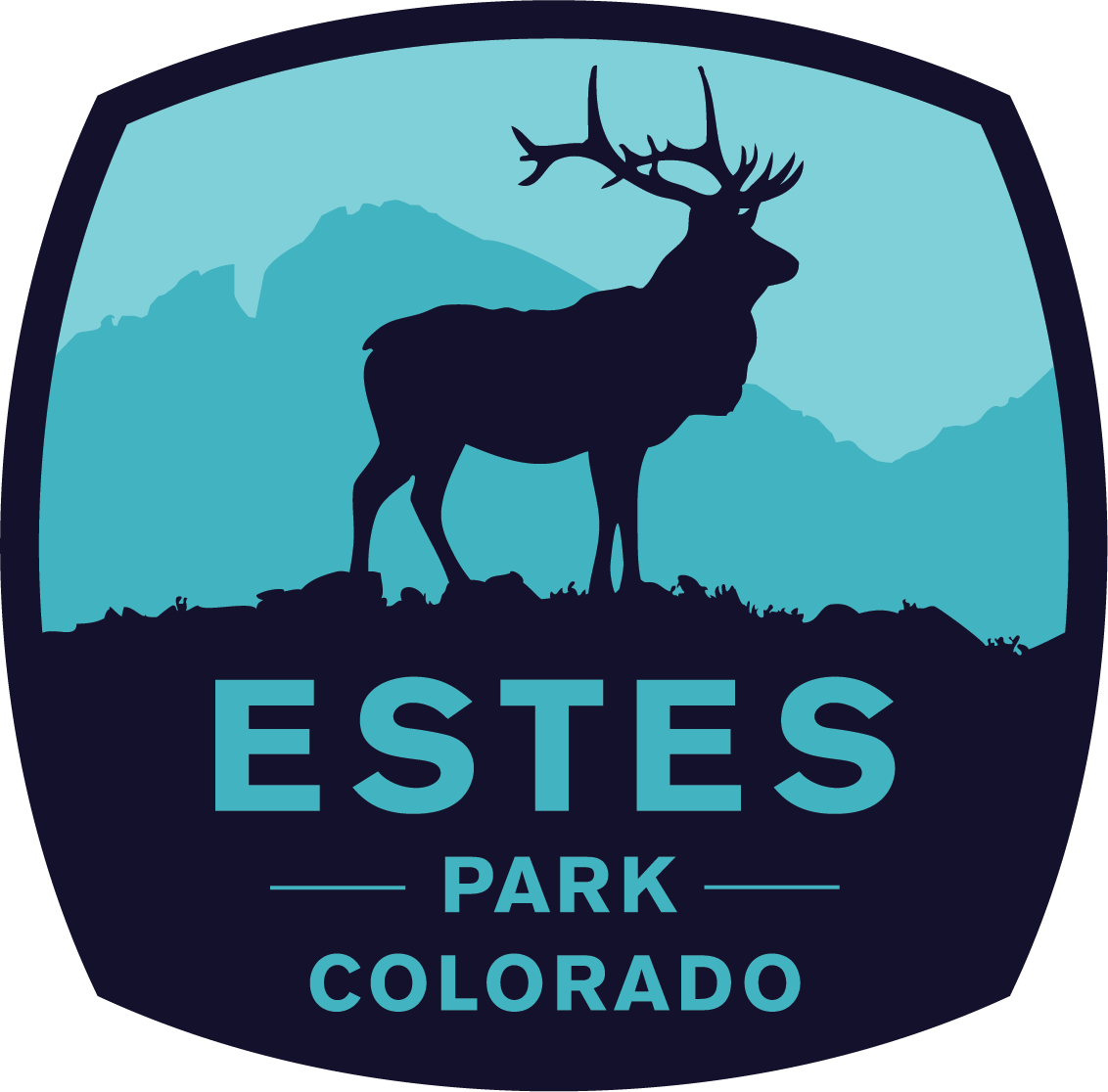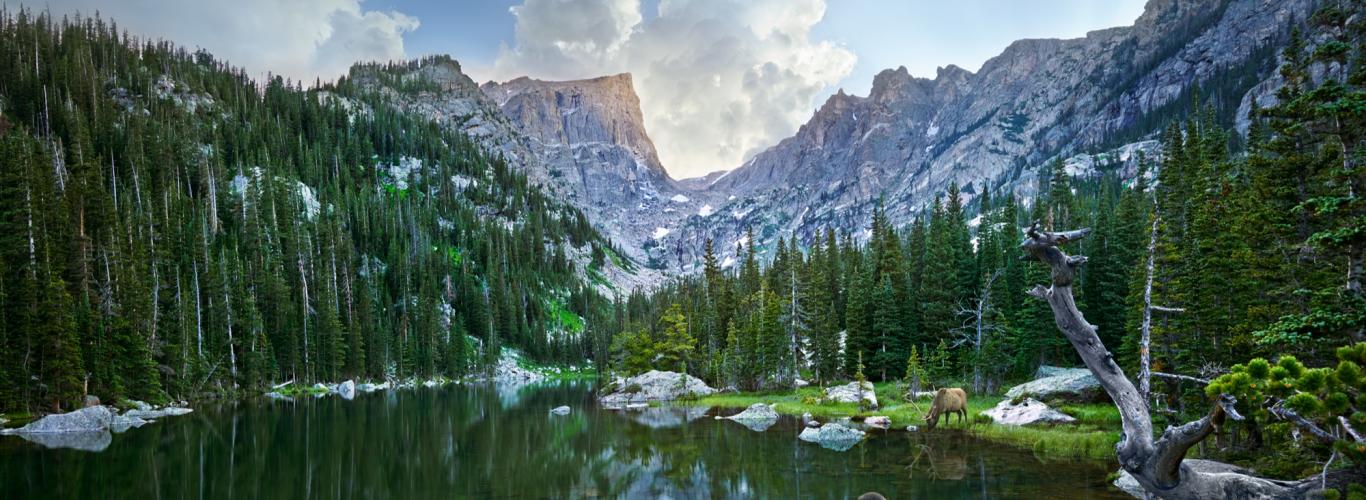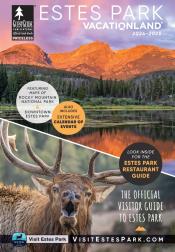A Stanley Hotel History: Part Two

F.O. Stanley enjoying his porch with a Stellar’s jay in Estes Park. (Courtesy Photo – Estes Park Museum)
Identical twins Freelan Oscar and Francis Edgar Stanley were born on June 1, 1849 in Kingfield, Maine to parents Solomon and Apphia Stanley.
A farmer and teacher, their father instilled a sense of education and entrepreneurship in his twin boys, two of seven siblings. The brothers would eventually go on to start the Stanley Dry Plate Company, a company that would make them wealthy men, and the Stanley Motor Carriage Company, which made the Stanley Steamer. They also enjoyed making violins and had a fondness for music.
But the story of The Stanley Hotel, which F.O. opened in 1909, started more than halfway across the world with the birth of Windham Thomas Wyndham-Quin, the fourth Earl of Dunraven, in 1841 in Ireland.
More commonly known as Lord Dunraven, he arrived in Estes Valley in Dec. 1872. As an avid sportsman, he was enthralled with the abundance of game in the valley, and the lack of people. It is also believed that he saw the possibilities for business ventures in this region that was starting to gain some recognition.

Shortly after his arrival in the valley, Dunraven started to acquire land. Although American citizens could homestead up to 320 acres, foreigners were not permitted to take advantage of this opportunity. Estes Valley also had not yet been surveyed for homesteading.
Instead, the shrewd Dunraven found a way to have the land surveyed and platted so it could be opened for filing by May of 1874 and then have U.S. citizens, probably mostly Denverites who had never seen Estes Park, claim the parcels. After hiring Theodore Whyte, a young engineer, to assist with his plan, Dunraven would buy the parcels back from the homesteaders for $5 to $10 an acre with the total median price of a parcel at $1,200. The titles were then transfered to Dunraven’s British holding company, Estes Park Company Limited.
In total, there were 31 purchases made for the 5,038 acres from these May 1874 filings, mostly lush property along rivers, creeks and springs, for $38,100. Additional purchases were made and by the time Dunraven was finished, he had about 6,400 acres in Estes Valley.
Even after Dunraven built the Estes Park Hotel and his hunting cabin along Fish Creek, he lost interest in Estes Valley and returned to Ireland in 1884, never to return to Estes Park.
Because of the prime real estate that Dunraven had acquired, including the land for the future Stanley Hotel, many suitors attempted to purchase the land. None had success until F.O. Stanley.
The Stanleys Arrive in Estes Park
F.O. Stanley suffered from tuberculosis, a lung infection caused by bacteria that was one of the leading causes of death in the early 1900s. The disease, also referred to as consumption, would destroy the lungs over time, coming and going in severity of coughing fits with thick sputum.
In 1903, after a severe recurrence of the disease, F.O.’s doctor advised him to head west to Colorado where the clean, crisp, dry air was believed to help tuberculosis patients. F.O., who was 53 years old, weighed only 118 pounds and told he only had months to live, and his wife, Flora, arrived in Denver on March 4, 1903, via train. His Stanley Steamer arrived a month later.

This 1908 photo of downtown Estes Park looking west over what is now Bond Park and Elkhorn Avenue is what the town looked like a year before The Stanley Hotel opened. (CL McClure, Photographer; Estes Park Museum – Courtesy)
As the temperatures warmed in the city with the arrival of summer heat, F.O.’s physician in Denver recommended he head to Estes Park. Flora and F.O. rented a cottage and started heading towards the mountains on June 29, 1903. Flora and their maid, Minnie Lundberg, took the train from Denver to Lyons and then boarded a stage up to Estes Park along a route that is now U.S. Highway 36.
F.O. followed in his Stanley Steamer, getting lost on the poor roads to Lyons. He stopped at Welch’s North Fork Hotel, a stage stop more recently known as Shelly’s Cottages three miles up the canyon from Lyons, for the evening. When proceeding on his route the next morning, the hotel owner questioned the ability of the horseless carriage. F.O. left the hotel at 9:10 a.m. and arrived at Sam Service’s general store in Estes Park at 11:00 a.m., a drive that took at least six hours by stage was completed in one hour and 50 minutes.
Even considering the challenging route to Estes Park, Flora and F.O. fell in love with Estes Park and purchased 8.4 acres of land to build a home in Sept. 1903. Today, their home is the Stanley Home Museum located on Wonderview Avenue and open for public tours.

The Stanley Home, known as Rockside, was the summer home of early Estes Park residents F.O. and Flora Stanley. (Dawn Wilson Photography)
The Stanleys knew this fledgling town that only had a couple of dirt roads and a handful of buildings was rustic by the best of descriptions. Estes Park was much different than the upscale accommodations and facilities the upper-class couple was used to on the East Coast. F.O., however, saw the potential for recreation and tourism in this valley.
Even before their home was completed in the summer of 1904, F.O. started working on improving the infrastructure of the town by improving the wagon road along the North St. Vrain Creek, the same route he took on his first journey to Estes Park.
In the spring of 1904, he raised funds from local business owners to improve this route, later partnering with the state of Colorado to finish the road. In June 1907, Stanley drove over the new road, now U.S. Highway 36, for the first time.
A Luxury Hotel Arrives in Estes Park
Then, in 1907, Stanley came upon an opportunity to buy Dunraven’s land. Burton D. Sanborn of Greeley arranged a deal to purchase Dunraven’s land for a reported price of $80,000. Sanborn did not, however, have the full amount and reached out to F.O. for assistance. The two partnered and completed the sale with Dunraven on June 16, 1908.
Interestingly, the plans for The Stanley Hotel started in early 1907, before the sale of the land where the hotel would be built was finalized. F.O. had the confidence to know this dream would happen; he knew he could build a resort in this rustic yet beautiful mountain valley that would resemble the opulent hotels familiar to him in New England.
Designed by F.O., architect T. Robert Wieger and contractor Frank Kirhoff in the Georgian Colonial Revival style, the 140-room hotel features a wood and steel frame built on a rocky hillside set against a backdrop of Lumpy Ridge. The south-facing hotel with unobstructed views of Longs Peak and other mountains of the Continental Divide was built with lumber hauled up from Denver on wagons and carts, as well as timber harvested from Hidden Valley in what is now Rocky Mountain National Park.

A Stanley Steamer sits in the lobby of The Stanley Hotel, one of the vehicles built by the company F.O. Stanley and his brother, F.E., started. (Dawn Wilson Photography)
Originally painted mustard yellow, a color that represented wealth, The Stanley Hotel also had a Porte Cochère, a covered parking area in front of the hotel that allowed guests to enter and exit their vehicles out of the weather. Inside, the most prominent feature in the lobby was the grand staircase, complete with spindles in sets of four designs to represent the four seasons.
By the time the hotel opened, it is estimated F.O. spent nearly $500,000 to complete the property, about $17 million today.
F.O. wanted not only a beautiful hotel but a destination that represented the luxury his circle would expect. As an example, when The Stanley Hotel opened its doors on June 22, 1909, it was the first all-electric hotel, including the kitchen, in the world. The guests were flabbergasted to find such luxury in the remote mountain valley.
In addition to the main hotel, the 160-acre campus included 10 other buildings. The Manor House, the winterized building to the east of the hotel, opened for the 1910 season. The Casino, now the Stanley Concert Hall, was completed with the main hotel in 1909 and contained two bowling alleys. And the Carriage House, the fourth building to the east, was also completed in 1909 and was originally built to house the Stanley Mountain Wagons that transported guests from the train stations of Lyons, Loveland and Longmont.
Stanley’s Impact on Estes Park
But F.O. couldn’t just have a grand resort without the luxuries his guests would expect — rustic town or not.

The Historic Fall River Hydroplant, built in 1909 and includes this generator, was the original source of electricity in Estes Park until the 1982 Lawn Lake Flood put it out of commission. (Dawn Wilson Photography)
Although F.O. developed much of the infrastructure in Estes Park for the benefit of his hotel, the town reaped the rewards as well, turning this little mountain town into a popular tourist destination in less than a decade. The establishment of RMNP in 1915, just six years after the opening of The Stanley Hotel, sealed the recreation and tourism path for Estes Park’s future.
In addition to the investment F.O. made to improve the route up to Estes Park, he also helped: fund the first bank in Estes Park; helped organize the Estes Park Water Company to supply water to the town; built the town’s first hydroelectric plant to generate electricity; donated the land for the first sewer line and invested in the installation and upkeep; helped form the Estes Park 18-Hole Golf Course; donated land for the town garbage dump; and donated 54 acres that would eventually become Stanley Park and Lake Estes.

F.O. Stanley enjoying his porch with a Stellar’s jay in Estes Park. (Courtesy Photo – Estes Park Museum)
Starting in 1906, F.O. also served as the president of the Estes Park Protective and Improvement Association, a role that helped re-energize the organization that led to the establishment of a fish hatchery in Estes Park, initiate the conversations that would create RMNP, and eventually bring elk back to the valley.
F.O. and Flora spent the rest of their lives in Estes Park, visiting each summer until their deaths in 1940 and 1939, respectively. He credited his time in Estes Park for why he lived nearly four decades longer than his doctor predicted in 1903.
The next installment of this six-part series will dive into the ownership, changes, and challenges of The Stanley Hotel from the end of F.O. Stanley’s involvement until John Cullen purchased the property in 1995.




